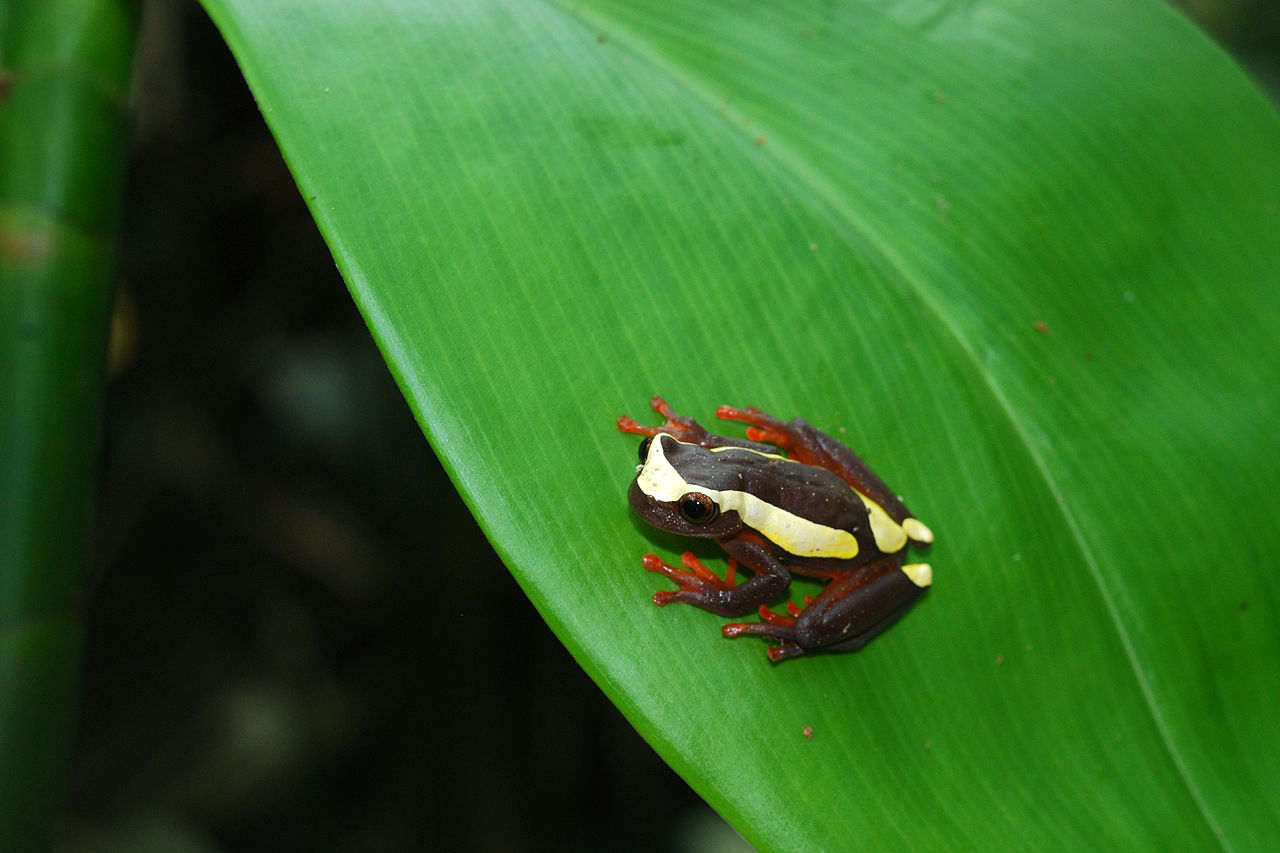Isthmian-Pacific Moist Forests
The ecoregion’s land area is provided in units of 1,000 hectares. The protection goal is the Global Safety Net (GSN1) area for the given ecoregion. The protection level indicates the percentage of the GSN goal that is currently protected on a scale of 0-10.
Bioregion: Central American Isthmian & Colombian Coastal Forests (NT24)
Realm: Central America
Ecoregion Size (1000 ha):
2,936
Ecoregion ID:
471
Conservation Target:
51%
Protection Level:
2
States: Panama, Costa Rica
The critically endangered clown frog, or Talamancan harlequin frog, is native to Costa Rica and Panama within the Isthmian-Pacific Moist Forest ecoregion. These small multi-coloured “frogs” are actually toads, despite their very frog-like appearance. They live along streamside in a very narrow range of streamside habitats, only moving away from the edge of the rushing water during flooding season to seek refuge in the forest. Recently it was discovered that they make a high frequency chirping sound and are preyed upon by water beetles.
The species has experienced a series of “extinction” and “rediscovery” in recent decades, as isolated pockets of their population were found, and later extirpated. Their restricted range and changes in climatic patterns were ascribed as major factors of their decline, together with the infectious disease Chytridiomycosis that target amphibians. Currently only one breeding population is known in Costa Rica with remnant populations in both Costa Rica and Panama.

The flagship species of the Isthmian-Pacific Moist Forests ecoregion is the clown frog. Image credit: Creative Commons
The Isthmian Pacific Moist Forests ecoregion extends along the Pacific lowlands and foothills of southern Costa Rica and Panama. The western margin occurs south of Costa Rica’s Central Valley and extends eastwards between the foothills of the Cordillera Central, the Talamanca Mountains, and the coastline. Several near-shore islands in the Chiriquí Gulf are also included in this ecoregion. Climate here is distinct from the surrounding moist forests: wetter with a shorter dry season. Annual rainfall ranges from 3,000 mm, in the lowlands to almost 6,000 mm at higher elevations. Average temperature ranges from a high of 27°C near the shore to a low of 21°C in the foothills.
This ecoregion holds distinct ecosystems with unique vegetation. Seasonally and permanently flooded areas create lagoons, marsh, palm swamp, and swamp forest. Along rivers and streams gallery forests occur, with trees reaching 70–80 m in height, including the wild cashew and kapok tree. Lowland forests with canopies reaching as high as 65 m include the cow tree and the endangered Anaxagorea costaricensis. Tree diversity is high, and few species are dominant in any given areas; there are at least 700 tree species within the Oso Peninsula of Costa Rica alone.
The lowland wet forests of the Pacific harbour both higher species richness and greater endemism than does the Atlantic slope, due to a more varied topography, climate, and seasonality. The reptile and amphibian species in the province of Chiriquí have the highest regional endemism and has the highest number of endangered species in Panama. Panama’s western pacific slope forests are considered both an Endemic Bird Area and a locality for threatened birds. The Golfo Dulce region of southwestern Costa Rica and far western Panama comprises a majority of the South Central American Pacific slope Endemic Bird Area.
Endemic species in the area include the brown-backed dove, white-crested coquette, charming hummingbird, Baird’s trogon, turquoise cotinga, riverside wren, and the spot-crowned euphonia among others. Corcovado National Park on the Osa Peninsula is one of the few forests that still supports large mammals such as Baird’s tapir, jaguar, and white-lipped peccary.
Approximately 1,600 km2 of the ecoregion’s remaining forest are protected, 25% of which occurs in Corcovado National Park on the Osa Peninsula. The habitats of the Pacific slope middle and lower elevations are severely underrepresented in both Costa Rica’s and Panama’s protected area systems. The Isthmian Pacific Moist Forests ecoregion as a whole is less than 17% protected. Habitats occurring between 500–1,000 m on the pacific slope are as little as 1%. Even the largest park in the ecoregion, Corcovado National Park (450 km2), is not considered large enough to support viable populations of its full vertebrate fauna indefinitely.
The greatest threat to the remaining ecoregion is the elimination of the few remaining forest fragments, especially in the middle elevations. Logging, burning, and conversion of forest to agriculture—particularly for cattle pasture, coffee, and other food crops—have decimated most of this ecoregion. Given the critical situation of the Isthmian Pacific Moist Forests, with little remaining natural habitat, most of the species dependent on this ecoregion are threatened with extinction.
The priority conservation actions for the next decade will be to: 1) develop wildlife connectivity corridors between the national parks, which are currently disconnected and allow little movement of species between highland and lowland habitats (for example connecting Corcovado National Park to the much larger La Amistad International Park); 2) explore wildlife friendly approaches to improve agriculture practices of African oil palm, pineapple, and other crops that are filling in the matrix between remnant forests; and 3) work with rural farms and indigenous groups to begin reforesting fallow lands, especially along river systems and drainages.
Citations
1. Powell, G. Palminteri, S. Schipper, J. 2018. Central America: Southern Costa Rica to the southwest coast of Panama. https://www.worldwildlife.org/ecoregions/nt0130 Accessed July 6, 2018.
2. Palminteri, S., G. Powell, A. Fernandez, and D. Tovar. 1999. Talamanca Montane-Isthmian Pacific Ecoregion-Based conservation plan: Preliminary reconnaissance phase. Report to WWF-Central America.
3. Stattersfield, A.J., M.J. Crosby, A.J. Long, and D.C. Wege. (1998). A global directory of Endemic Bird Areas. BirdLife Conservation Series. BirdLife International,Cambridge, U.K.
4. Pounds, J., Puschendorf, R., Bolaños, F., Chaves, G., Crump, M., Solís, F., Ibáñez, R., Savage, J., Jaramillo, C., Fuenmayor, Q. & Lips, K. 2010. Atelopus varius. The IUCN Red List of Threatened Species 2010: e.T54560A11167883. http://dx.doi.org/10.2305/IUCN.UK.2010-2.RLTS.T54560A11167883.en Accessed July 25, 2018



